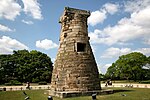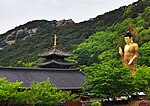List of World Heritage Sites in South Korea
The United Nations Educational, Scientific and Cultural Organization (UNESCO) World Heritage Sites are places of importance to cultural or natural heritage as described in the UNESCO World Heritage Convention, established in 1972.[2] The Republic of Korea accepted the convention on 14 September 1988, making its historical sites eligible for inclusion on the list. As of 2021, there are fifteen World Heritage Sites in South Korea, including thirteen cultural sites and two natural sites.[1]
The first three sites of South Korea, Haeinsa Temple Janggyeong Panjeon, the Depositories for the Tripitaka Koreana Woodblocks, Jongmyo Shrine and Seokguram Grotto and Bulguksa Temple, were inscribed on the list at the 19th Session of the World Heritage Committee, held in Berlin, Germany in 1995.[3] In 2007, Jeju Volcanic Island and Lava Tubes became the first site selected for its natural significance.[4] South Korea's fourteenth heritage inscription, Seowon, Korean Neo-Confucian Academies, was added to the list in 2019,[5] followed by Getbol, Korean Tidal Flats selected as the country's second natural world heritage in 2021.[6]
In addition to its inscribed sites, South Korea also maintains twelve properties on its tentative list.[7]
World Heritage Sites[]
UNESCO lists sites under ten criteria; each entry must meet at least one of the criteria. Criteria i through vi are cultural, whereas vii through x are natural.[8]
| Site | Image | Location | Year listed | UNESCO data | Description |
|---|---|---|---|---|---|
| Seokguram Grotto and Bulguksa Temple | 
|
North Gyeongsang | 1995 | Cultural: (i)(iv) |
[9] |
| Haeinsa Temple Janggyeong Panjeon, the Depositories for the Tripitaka Koreana Woodblocks | 
|
South Gyeongsang | 1995 | Cultural: (iv)(vi) |
[10] |
| Jongmyo Shrine | 
|
Seoul | 1995 | Cultural: (iv) |
[11] |
| Changdeokgung Palace Complex | 
|
Seoul | 1997 | Cultural: (ii)(iii)(iv) |
[12] |
| Hwaseong Fortress | 
|
Gyeonggi | 1997 | Cultural: (ii)(iii) |
[13] |
| Gochang, Hwasun and Ganghwa Dolmen Sites | 
|
Incheon, North Jeolla and South Jeolla | 2000 | Cultural: (iii) |
[14] |
| Gyeongju Historic Areas | 
|
North Gyeongsang | 2000 | Cultural: (ii)(iii) |
[15] |
| Jeju Volcanic Island and Lava Tubes | 
|
Jeju | 2007 | Natural: (vii)(viii) |
[16] |
| Royal Tombs of the Joseon Dynasty | 
|
Gyeonggi, Seoul and Gangwon | 2009 | Cultural: (iii)(iv)(vi) |
[17] |
| Historic Villages of Korea: Hahoe and Yangdong | 
|
North Gyeongsang | 2010 | Cultural: (iii)(iv) |
[18] |
| Namhansanseong | 
|
Gyeonggi | 2014 | Cultural: (ii)(iv) |
[19] |
| Baekje Historic Areas | 
|
South Chungcheong and North Jeolla | 2015 | Cultural: (ii)(iii) |
[20] |
| Sansa, Buddhist Mountain Monasteries in Korea | 
|
North Chungcheong, North Gyeongsang, South Chungcheong, South Gyeongsang and South Jeolla | 2018 | Cultural: (iii) |
[21] |
| Seowon, Korean Neo-Confucian Academies | 
|
Daegu, North Gyeongsang, North Jeolla, South Chungcheong and South Gyeongsang | 2019 | Cultural: (iii) |
[22] |
| Getbol, Korean Tidal Flats | 
|
North Jeolla, South Chungcheong and South Jeolla | 2021 | Natural: (x) |
[23] |
Tentative list[]
In addition to sites inscribed on the World Heritage List, member states can maintain a list of tentative sites that they may consider for nomination. Nominations for the World Heritage List are only accepted if the site was previously listed on the tentative list.[24] As of 2021, South Korea maintains twelve properties on its tentative list:[7]
- Ancient Mountain Fortresses in Central Korea
- Daegokcheon Stream Petroglyphs
- Gaya Tumuli of Gimhae – Haman
- Kangjingun Kiln Sites
- Mt. Soraksan Nature Reserve
- Naganeupseong, Town Fortress and Village
- Oeam Folk Village
- Salterns in South Jeolla Province - Sinan and Yeonggwang
- Seoul City Wall
- Sites of fossilized dinosaurs across the southern South Korean coast
- Stone Buddhas and Pagodas at Hwasun Unjusa Temple
- Upo Wetland
See also[]
| Wikivoyage has a travel guide for South Korea. |
References[]
- ^ a b "Republic of Korea". UNESCO. Retrieved 30 June 2018.
- ^ "The World Heritage Convention". UNESCO. Retrieved 21 September 2010.
- ^ "Report of the 19th Session of the Committee". UNESCO. Retrieved 10 August 2016.
- ^ "Decision: 31 COM 8B.12". UNESCO. Retrieved 10 August 2016.
- ^ "Seowon, Korean Neo-Confucian Academies". UNESCO. Retrieved 11 July 2019.
- ^ "Getbol, Korean Tidal Flats". UNESCO. Retrieved 29 July 2021.
- ^ a b "Tentative List – Republic of Korea". UNESCO. Retrieved 4 January 2020.
- ^ "UNESCO World Heritage Centre The Criteria for Selection". UNESCO World Heritage Centre. Retrieved 17 August 2018.
- ^ "Seokguram Grotto and Bulguksa Temple". UNESCO. Retrieved 10 August 2016.
- ^ "Haeinsa Temple Janggyeong Panjeon, the Depositories for the Tripitaka Koreana Woodblocks". UNESCO. Retrieved 10 August 2016.
- ^ "Jongmyo Shrine". UNESCO. Retrieved 10 August 2016.
- ^ "Changdeokgung Palace Complex". UNESCO. Retrieved 10 August 2016.
- ^ "Hwaseong Fortress". UNESCO. Retrieved 10 August 2016.
- ^ "Gochang, Hwasun and Ganghwa Dolmen Sites". UNESCO. Retrieved 19 February 2017.
- ^ "Gyeongju Historic Areas". UNESCO. Retrieved 10 August 2016.
- ^ "Jeju Volcanic Island and Lava Tubes". UNESCO. Retrieved 10 August 2016.
- ^ "Royal Tombs of the Joseon Dynasty". UNESCO. Retrieved 10 August 2016.
- ^ "Historic Villages of Korea: Hahoe and Yangdong". UNESCO. Retrieved 10 August 2016.
- ^ "Namhansanseong". UNESCO. Retrieved 10 August 2016.
- ^ "Baekje Historic Areas". UNESCO. Retrieved 10 August 2016.
- ^ "Sansa, Buddhist Mountain Monasteries in Korea". UNESCO. Retrieved 30 June 2018.
- ^ "Seowon, Korean Neo-Confucian Academies". UNESCO. Retrieved 11 Jul 2019.
- ^ "Getbol, Korean Tidal Flats". UNESCO. Retrieved 29 July 2021.
- ^ "Tentative Lists". UNESCO. Retrieved 7 October 2010.
- Lists of World Heritage Sites
- Lists of places in South Korea
- World Heritage Sites in South Korea
- Lists of tourist attractions in South Korea

